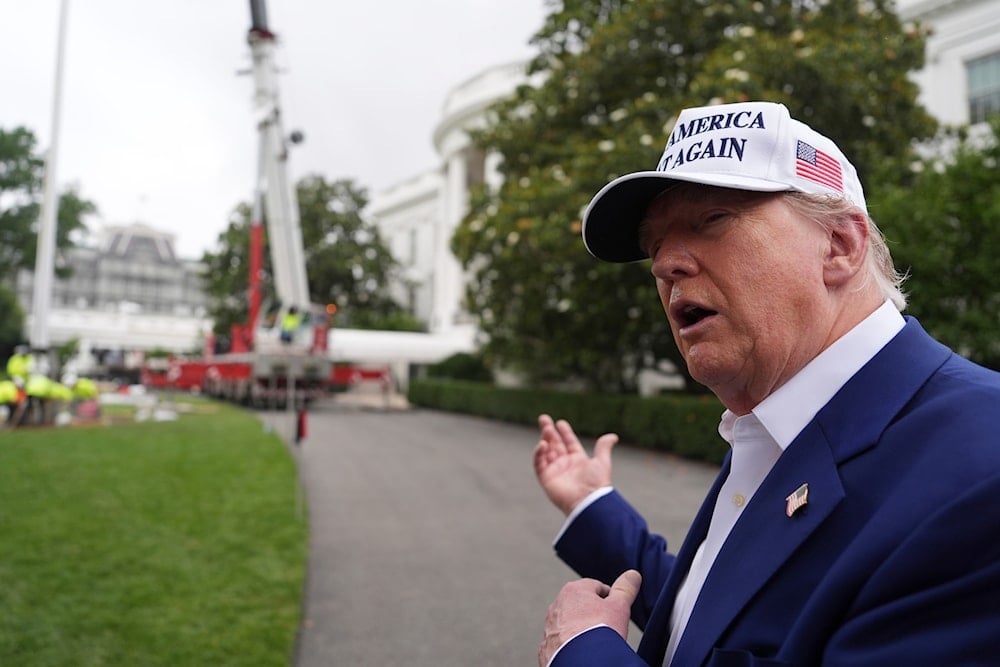Federal Reserve keeps interest rates unchanged despite Trump pressure
The US Federal Reserve maintains interest rates while forecasting a 3% inflation rate in 2025.
-

US President Donald Trump speaks as a flag pole is installed on the South Lawn of the White House, Wednesday, June 18, 2025, in Washington. (AP)
The US Federal Reserve held interest rates steady while signaling potential cuts later this year, even as President Donald Trump breaks from precedent by publicly pressuring for lower rates.
Policymakers at the American central bank raised their inflation forecasts for the year while lowering growth expectations, as the US president continues to defend his contentious tariff policies, The Guardian reported on Wednesday.
They noted that while uncertainty has diminished, it remains substantial, as Fed Chair Jerome Powell warned that officials anticipate Trump’s tariffs will drive prices higher throughout the summer.
“Increases in tariffs this year are likely to push up prices and weigh on economic activity,” Powell said, adding that “the effects on inflation could be short-lived, reflecting a one-time shift in the price level. It’s also possible that the inflationary effects could be more persistent.”
Powell further stated that avoiding sustained inflation would hinge on the scale of the tariff impacts and the duration before those effects fully influence prices.
Inflation expected to increase by 3% in 2025
Projections released alongside its latest decision on Wednesday showed central bank policymakers now expect inflation to rise by a median rate of 3% this year, an increase from their previous estimate of 2.7%, and demonstrate how far the US economy remains from meeting the Fed’s 2% inflation target.
With Trump’s aggressive tariff agenda continuing to disrupt the global economy while fueling concerns about price growth, Fed officials have consistently emphasized the ongoing economic uncertainty ahead.
Projections show they now expect the US economy to grow by a median rate of 1.4% this year, lowering their outlook from March's 1.7% estimate that had already marked a notable reduction from December's 2.1% projection.
Uncertainty is the word
The Federal Reserve confirmed on Wednesday that it had maintained the targeted federal funds rate at a range of 4.25% to 4.5% after its rate-setting open market committee's latest two-day meeting, while stating that uncertainty about the economic outlook had diminished but remained elevated.
The closely watched "dot plot" revealing policymakers' rate projections showed most officials anticipate at least two rate cuts in 2025, followed by additional reductions in subsequent years, though disagreement persists about the path ahead as seven of the nineteen committee members expect no rate cuts whatsoever this year.
Chair Powell noted diverse committee views on economic forecasts and policy responses, while the Fed's statement acknowledged solid economic expansion and low unemployment despite elevated inflation, attributing recent volatility partly to trade fluctuations.
The central bank has maintained its policy independence despite pressure from the White House, with Powell emphasizing during his recent meeting with the president that the Fed's decisions would be guided solely by economic data and its implications for the future outlook.
S&P 500 and Dow Jones Industrial Average stabilize
Wall Street initially rallied following Wednesday's announcement before giving back those gains as trading progressed, with both the benchmark S&P 500 and Dow Jones Industrial Average stabilizing near unchanged levels by mid-afternoon in New York.
Federal Reserve continues to face significant uncertainty in its economic forecasts, which reinforces its tendency to respond to developments rather than act preemptively. Ryan Sweet, Oxford Economics' chief US economist, told The Guardian.
Powell voiced concerns about funding reductions affecting US statistical agencies that generate critical economic data while emphasizing the Fed's continued ability to fulfill its mandate, though warning these cuts could lead to increased volatility in economic surveys due to staffing reductions.

 4 Min Read
4 Min Read










